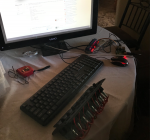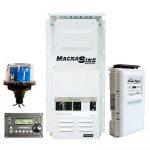By pure luck
?
By pure luck





Saw someone on Wednesday who had pictures of your Ambulance on his phone. Picked up my MRAP transfercases in Roby TX Wednesday afternoon and had a nice visit with the gentleman. Small world when it comes to MRAP transfercases and axles.
No. He did say that you're looking for another one though.Yep he is a good guy. Do you happen to have a spare transfer case?
Circuit breakers are a mixed blessing -- convenience plus PITA. The first thing you need to avoid is a thermal circuit breaker - you want to use a "hydraulic/magnetic" type breaker. This type's performance is not affected by temperature.You know those days when you say to yourself "Oh shizt, why do I do that". Well I am having one of those days. Just for a bit of background this truck has 840w of solar running through a Midnite Classic 150. Which some numb nutz decided would be better off located inside the living area than outside. Well that has come back to bite me on the ********.
Symptoms: Batteries very low 8.5v and solar not charging the system.
Initial thoughts were "oh its under cover (shadecloth) therefore there was no solar. This remarkable deduction was made at about 10:30 PM before a 5AM flight out of town for a week. So I proceeded to jump start it and drive it out into the direct sunlight.
Returned 5 days later and checked again. Batteries now at 5v. But it was dark so I left it for the next day.
Next day I discovered that the breaker on the output of the MPPT controller had tripped (80 amp). SO I reset it and it started pumping in the amps 35 according to the remote. Knowing these things don't trip without a reason I checked all the connections and did some math. The absolute best the solar should be able to theoretically achieve is 70 amps (840W @ 12v). Realistically 60 would be the max in ideal conditions. So there is no way the breaker tripped from over current supplied by the controller. A check of the cable run showed that there was no shorts or faults. Reset the breaker and promptly went out of town again.
5 days later I come back to the truck and once again the breaker had tripped. SO now I had to throw on my Sherlock Holmes deerstalker hat and get down to it. Problem is I don't have one of those hats so I made do with an Australian bushmans hat.
Once again I checked all connections and the cables for damage. All fine. Then I set the maximum output from the MPPT controller to 60 amps. With a clamp meter on the output cable I sat in the truck and watched what was happening. Outside temperatures were well over 100 inside was actually hotter (more on this later). After about 1/2 an hour I noticed the MPPT controller bouncing between Float, Bulk and Absorb modes. On checking the clamp meter it was reading 29 amps. Then the breaker tripped.
So lesson 1 those inline breakers do not handle 100 + degrees without severe degradation of the trip rating. (I replaced the 80amp breaker and the same thing happened). Replaced it with a 100amp breaker and it is currently working OK. (luckily the breaker is protecting about 36 inches of cable)
Lesson 2 was while I was trying to figure out why the box was so hot. According to the MPPT controller the temp in the box was 123f and the outside battery temp was 102f. Then I checked the temp of the actual controller and it was 137f. By putting the controller inside the box I had introduced a massive heat source and also probably by having it in the enclosed box reduced the airflow to allow it to keep itself cool. Yep that was my "need to give yourself an uppercut numb nutz" moment.
Next steps:
1- Order some good quality dual pole DC breakers to replace the inline ones. (any suggestions)
2- Install thermostatically controlled (and controlled from the inverter and charge controller) fans which draw air from the region of the inverter and the controller and pump it outside.
3- As part of any future projects look at relocating the MPPT controller to an area outside the living area. (same with the inverter but we rarely use it so the priority is not as high)
4- As part of the replacement of the control system for the box I need to have circuit breaker trip monitoring, internal temp monitoring, vent fan control, remote monitoring of the solar, batteries, fridges (my beer got boiled a couple of times) along with the rest of the stuff I have dreamed up.
Sorry guys I work in metric, no one will ever convince me that the "standard/US" system is better. I am ambidextrous enough for general conversation and daily use but anything scientific needs the metric system. (Ask NASA and Lockheed Martin after the Mars Climate Orbiter Craft fiasco in 1999)
View attachment 530975View attachment 530976
The beginning of the monitoring/control system. Currently stress testing the relay board and CPU. Running/switching continuously for over 2 weeks now.
View attachment 530978
Or don't put it inside, but in a well ventilated exterior cabinet as was done by OEM.I dug into the Carling circuit breakers a little, and with a thermal breaker .....
So, it looks like even a 100 amp breaker is too small unless you can cool the breaker to below 50C -- then the 1.33 derate factor will let you use a 100 amp breaker.
Or, go to a hydraulic/magnetic breaker
What happened to that?
